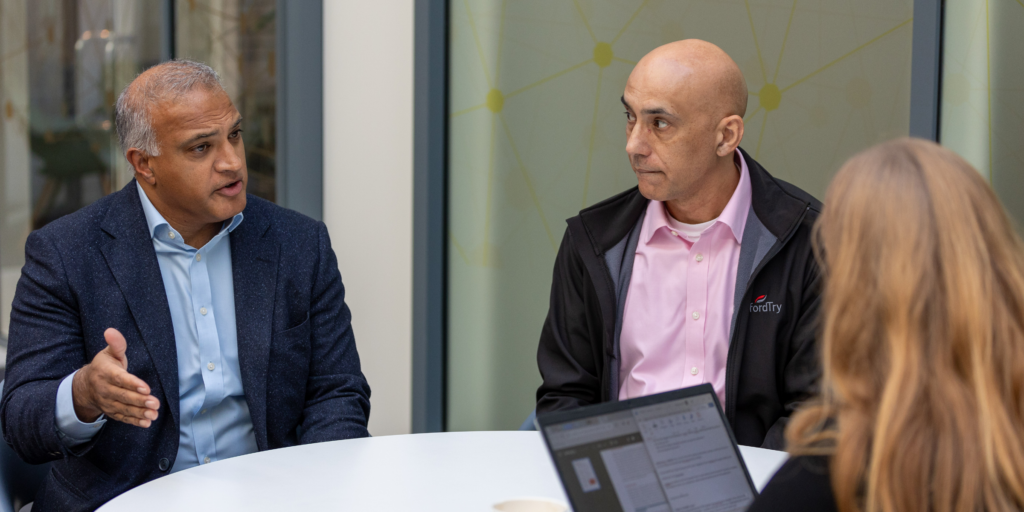As the post-modern ERP market matures there’s more choice than ever and the opportunities for ERP buyers could not be better.
It used to be said that no-one ever got sacked for choosing Oracle or SAP. Now it’s more likely that you could be sacked if you fail to consider the alternatives. Whilst it is still true that the red and blue ERP products are more functionally rich, more mature and generally offer a more complete solution, other vendors are now able to pitch themselves as a valuable alternative.
Historically, ERP suites sat firmly in the back office to transact and record. Fast-forward to 2019 and the current ERP system is much more people orientated and plays a pivotal role in many front-line services where digital technology is changing the shape of sales, marketing, employee experience, and customer contact.
We are already in the second phase of cloud-enabled business applications and that is a good thing for customers. The first flavour of SaaS products were a paler version of their on-premise counterparts. Many lacked the depth of functionality that had been available through installed applications and were largely untested products released to a naïve and expectant audience. Over the years the offerings and applications have improved, and today, most are a match for their predecessors in terms of depth, breadth and usability. The vendors ‘learnt on the job’ and now offer a portfolio of SaaS applications that, in theory, can live up to the hype.
Buyer knowledge is catching up
However, while the vendors have been busy bringing their products and services up to scratch, ERP buyers have been busy too. They have been watching and learning at the same rate and many are far more clued-up today than they were when cloud apps and infrastructure were first thrust into the limelight some 10 years ago.
At that time, there were very few genuine use cases of cloud applications delivering the cost savings and competitive advantages that went with the story. ERP buyers were faced with taking a leap of faith based on untried and untested methodologies and economics. Some did, but many didn’t. And those that did will certainly have spent some time reflecting on the choices and decisions made when SaaS was in its infancy.
Some of the early narrative around cloud adoption was blunt and unhelpful; ‘there is only one game in town and if you don’t join the cloud you’re on your way to being out of business,’ or words to that affect. Oracle and SAP both initiated plans to move their customers to the cloud by bringing an end to support for on-premise products. Both announcements fell flat and neither resulted in the kind of uptake that the two biggest ERP vendors hoped for. In fact, the only outcome either announcement really achieved was to give a boost to the likes of Rimini Street and to force CIOs to seriously evaluate their ERP roadmap – often resulting in a broader choice of technology being considered.
Many businesses with stable installed application estates can bring some of their processes into the 21st century with tweaks rather than total disruption.
Locked out by enforcing lock in
Lock-in had been an issue in the ERP sector for decades. Whether you were legally obliged or metaphorically handcuffed, it was very difficult to move away from your technology partner once an ERP solution had been living and breathing in your business for a decade or more. Even dissatisfied ERP customers chose to stay with their incumbent providers because a technical upgrade was always easier than full scale abandonment. Like an unhappy marriage, it was less painful to stay put than to consider pastures new.
However, the dawn of SaaS applications had an unintended consequence for the big ERP players. It actually opened the eyes of many CIOs to the possibility of looking for credible alternatives. Faced with a deadline to be off installed applications, and the task of radically changing business models to fit with cloud methodologies, ERP buyers began to evaluate the choices more closely.
IFS, Unit4 and Infor are three vendors that have benefitted from the opportunity these market dynamics have presented. Once considered niche players, they now offer stable, dynamic and broad software solutions to match their bigger rivals. They have hired-in top talent (often from Oracle and SAP) to spearhead growth and have managed to create a culture that is seen as refreshing and ‘friendly’ when compared to the corporate beasts from Redwood Shores and Walldorf.
Other more niche players like Advanced, Acumatica and FinancialForce offer exceptionally good applications with vertical or horizontal functionality – although some of the more niche players lack the breadth that may be required by larger enterprises, their products and services should not be discounted. And Sage is also resurgent with a much more enterprise-friendly portfolio that will soon include the Intacct product range that it acquired back in 2017. Intacct is a cloud-native suite of applications that will fill a gap in the Sage offering and appeal to customers who want a true SaaS product for financial management activities.
However, it remains true that in many cases it’s still a toss-up between blue and red for the largest of enterprises (although Workday is keen to have its say on that matter). Oracle’s Cloud Applications are the most functionally rich of all the ERP vendors and they maintain market-leading status in the SaaS ERP space. SAP’s S/4 offering is already on its fifth release and it is now equally as rich as the ECC product it replaces. And Workday’s financial offering is rapidly becoming more sophisticated, save for some localisation issues that have affected some global roll-outs, and is now a true match for large enterprises when compared to Oracle and SAP.
What’s wrong with SaaS?
There is no doubt that the benefits of SaaS and evergreen applications have been overstated (in some, perhaps many, cases) and the furore has started to calm. Claims that a new solution could be implemented in a matter of days turned out to be false and although some vendors still persist with this narrative, most are taking a more sensible approach to promoting the virtues (and the challenges) of SaaS.
Cloud applications were touted as a magic-wand that would reduce costs, drive efficiencies and boost competitiveness – and while those three statements are all true – the simple fact is that many of the early adopters of SaaS applications underestimated the time, cost and disruption involved in migrating to the cloud, while the benefits that should have been realised were lost in poorly conceived projects and difficult implementations. I think we have been here before.
It is not so much that the technology itself under-delivered. More, that the associated business case and cultural change that is required to breathe life into SaaS was never fully explained by the vendors and often overlooked by consultancies. There are several very good examples where SaaS projects have failed – not because the technology didn’t work or the partner did a poor job of implementing it – simply because the customer was ill-prepared for the root and branch change that true SaaS demands.
Some of the cost benefits of moving to a SaaS product have also had to be adjusted. Shifting from a Capex to an Opex model to support business applications was the first hurdle to overcome, and while CFOs rankled with the fundamental change in how you pay for ERP, they also started to focus more attention to the TCO of a new ERP system hosted in the cloud. At first glance the TCO for SaaS is compelling. But, as infrastructure options have become more complex. and updates to applications have become more frequent, new costs have replaced old costs and the true TCO for most SaaS deployments is not so different to those of historic ERP ownership models.
We could all do with a little extra intelligence. But just how much more intelligent does a business need to be in order to survive?
Economy erosion in shifting ERP
As the options and choices for customers evolve so does the complexity of managing an ERP landscape where loosely coupled integrations of different cloud points, products and services should create an agile and interconnected whole. This fragmentation of an organisation’s application estate was heralded as a break from the monolithic lock-in of big ERP that would deliver much sought after agility and cost-savings. Although there are merits to this argument, when the level of integration becomes complicated and the various components reside on different clouds using different cloud models, there is potential for an erosion of the economies that cloud should deliver.
However, it’s not all doom and gloom for SaaS and ERP. The breadth of choice that is now available to customers means that there is a solution for everyone. It may be a single vendor approach for large enterprises that want to harness the full power of Oracle, SAP, Workday or Microsoft. Or, it may be a best of breed solution that captures the most compelling elements from a variety of suppliers. The challenger vendors are starting to chip away at the upper end of the ERP market as their focus on products that deliver specific outcomes are able to return quicker and more measurable ROI.
I am a strong advocate of utilising the newest and best technologies available but buyers should not be blinded by the lights. It doesn’t matter which vendor you choose or which flavour of infrastructure you select; what matters is selecting the right solution for your business now and in the near future. Enterprise customers may make decisions based on a 10 year horizon but smaller organisations need only think about what is immediately round the corner. Not every business is going to see the kind of disruption that is driving digital transformation. Or is digital transformation driving disruption? Sometimes I can’t remember…
All businesses can benefit from reducing the grunt work on their accounts, automating a few processes and bringing in smarter analytics. But that’s not disruption and it’s not digital transformation. The very notion of digital transformation tries to conjure up an image of luddite businesses that still use quill and ink emerging from their technological slumber and miraculously becoming beacons of modern commerce just by using cloud apps. That’s not reality. In the main, most businesses already operate digital systems – in fact they all do. They may not be truly connected with IoT devices strapped to every Bic biro and paperclip, but who needs that anyway? Some do, most don’t. All businesses operate digitally and have been doing so for decades. What SaaS offers isn’t a conversion to digital it’s a conversion to being connected and intelligent.
Ask yourself what problem are you trying to address and find the solution that solves that problem in the simplest way. If your erp vendor can’t demonstrate that, find one that can
Calculate the level of intelligence to aim for
We could all do with a little extra intelligence. Whoever said I want to be less intelligent? But just how much more intelligent does a business need to be in order to survive? Some will need more intelligence to complete, some less. Some will prosper through small changes, some will require wholesale change. Some may benefit from introducing micro projects that can have a big impact. Others will require enterprise-wide remodelling to compete on a global scale.
What this all amounts to is that there isn’t a one-size-fits-all answer or approach to modern ERP and digital transformation. It is not the case that a business which does not embrace all of the newest emerging technologies will fail, or anything even close to that. Many businesses with stable installed applications can bring some of their processes into the 21st century with tweaks rather than total disruption. They can make cost savings through ‘as-a-Service’ infrastructure and lighten the burden of managing datacentres and server rooms. Hosting and infrastructure used to be a binary choice between on-prem and cloud; now more creative architectures that include some on-prem and a mix of public and private cloud are available. They can integrate the most valuable emerging technologies to co-exist with their core back office functions and gain new insights and efficiencies without having to tear up the rule book. All ERP users have an unprecedented opportunity to re-evaluate how technology integrates with their business. It can open up new opportunities, make companies more efficient and dramatically improve user and customer experience. But only the right mix of technology, coupled with the right vendor and partner can deliver all of the outcomes that post-modern ERP promises. There is a very simple way to define what the right technology is; ask yourself what problem are you trying to address and find the solution that solves that problem in the simplest way. If your ERP vendor can’t demonstrate that, find one that can.





